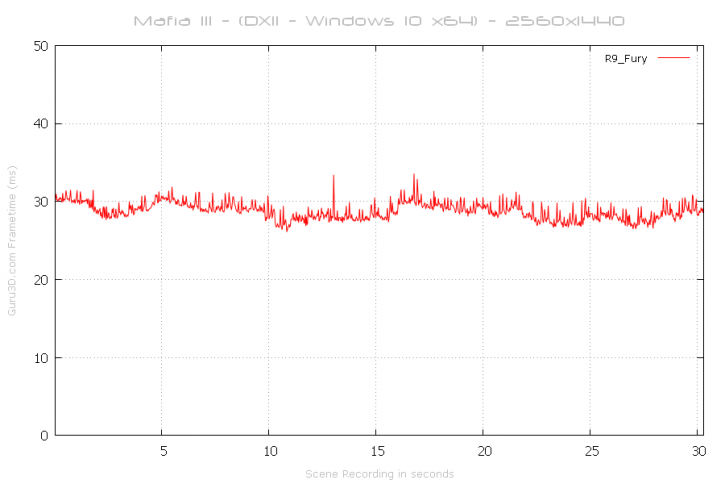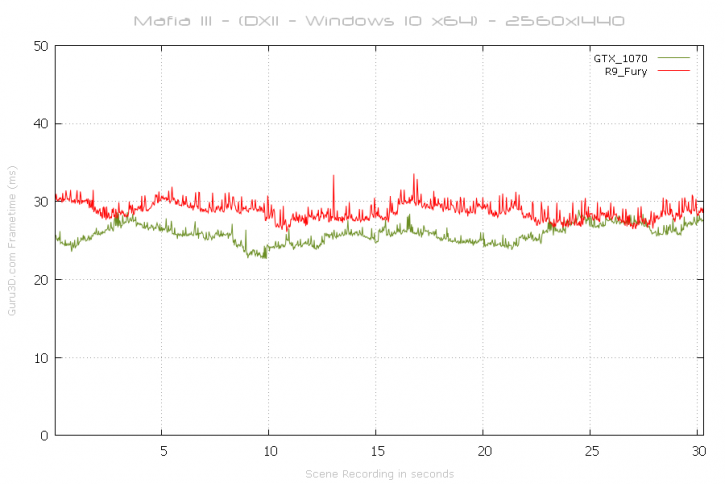(FCAT) Game Frametime Analysis
Frametime and latency performance
With FCAT we will look into Frame Experience Analysis. Basically with the charts shown we are trying to show you graphics anomalies like stutters and glitches in a plotted chart. Lately there has been a new measurement introduced, latency measurements. Basically it is the opposite of FPS.
- FPS mostly measures performance, the number of frames rendered per passing second.
- Frametime AKA Frame Experience recordings mostly measures and exposes anomalies - here we look at how long it takes to render one frame. Measure that chronologically and you can see anomalies like peaks and dips in a plotted chart, indicating something could be off.
| Frame time in milliseconds |
FPS |
| 8.3 | 120 |
| 15 | 66 |
| 20 | 50 |
| 25 | 40 |
| 30 | 33 |
| 50 | 20 |
| 70 | 14 |
We have a detailed article (read here) on the new FCAT methodology used, and it also explains why we do not use FRAPS anymore. Frametime - Basically the time it takes to render one frame can be monitored and tagged with a number, this is latency. One frame can take say 17 ms. Higher latency can indicate a slow framerate, and weird latency spikes indicate a stutter, jitter, twitches; basically anomalies that are visible on your monitor.
What Do These Measurements Show?
What these measurements show are anomalies like small glitches and stutters that you can sometimes (and please do read that well, sometimes) see on screen. Below I'd like to run through a couple of titles with you. Bear in mind that Average FPS often matters more than frametime measurements.
Above an FCAT plot of latency relative to FPS in percentiles. We use the Geforce GTX 1070 and the Radeon R9 Fury.
I often get asked the question why we do not include the faster Fury X here, well FCAT is dependant of a DVI monitor output, and AMD is not implementing them any more on their reference products. Only board partner cards release DVI enabled products. Hence the R9 Fury we use is the STRIX from ASUS, as it has a proper DVI output connector. So at 50% you could consider to be the average frame-rate. The cards are nice and close and cuddly to another. The plot is based on the first 31 seconds measured in the benchmark.
Frame Pacing / Frametime
Above a the frame-time results plot of the test run @ 2560x1440 (WQHD) performed with a GeForce GTX 1070 in 2560x1440 (WQHD). That's reasonably nice rendering really. BTW in the recorded scene we are driving around in a car, on ground in building segments will often get higher FPS. Frame pacing and timing wise this is good.
And above the R9 Fury. We see somewhat wilder frame-time behaviour, this is noticeable in game as the (all) Radeon cards do seem to struggle a little more with Mafia III. In all fairness, this is an Nvidia optimized title much like AMD has a lot of AMD optimized ones. Regardless, this is still really okay frame-time behaviour overall. Remember you are looking at close to roughly 2000 rendered frames; all nicely plotted to see if anything massively weird happens. That is just not the case. And now let us overlay and combine the two:
Both graphics card manufacturers seem to have the game well under control relative to frame pacing, close to excellent for Nvidia and pretty good for AMD.





